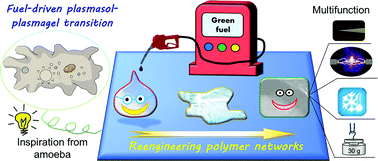Amoeba-inspired reengineering of polymer networks†
Abstract
Some living organisms such as amoebas and slime molds have the capability to reengineer their bodies freely by undergoing out-of-equilibrium events. By contrast, synthetic materials usually have fixed structures, properties and functions once synthesized, and it remains challenging to reengineer these materials arbitrarily. Inspired by the habits of amoebas, here we report the fuel-driven reengineering of covalent adaptable polymer networks into multifunctional materials. The sugar-fueled production of carbon dioxide mediated by a microbial metabolism process is used to program a temporary pH change in borate ester bond-based polymer hydrogels, thereby regulating the repeatable formation of transient sols with a tunable lifetime. Diversified properties and functions including reshapability, mobility, fission-fusion ability, outstanding mechanical properties, remarkable acid resistance, magnetic responsiveness, self-recoverable electrical conductivity, and impressive low-temperature strain sensitivity can be obtained via the fuel-driven transient liquefaction of hydrogels, which essentially profit from either the intrinsic fluidity of the transient sols or the engulfment of extrinsic functional molecules and nanomaterials, reminiscent of the functions of amoebas’ pseudopods.



 Please wait while we load your content...
Please wait while we load your content...